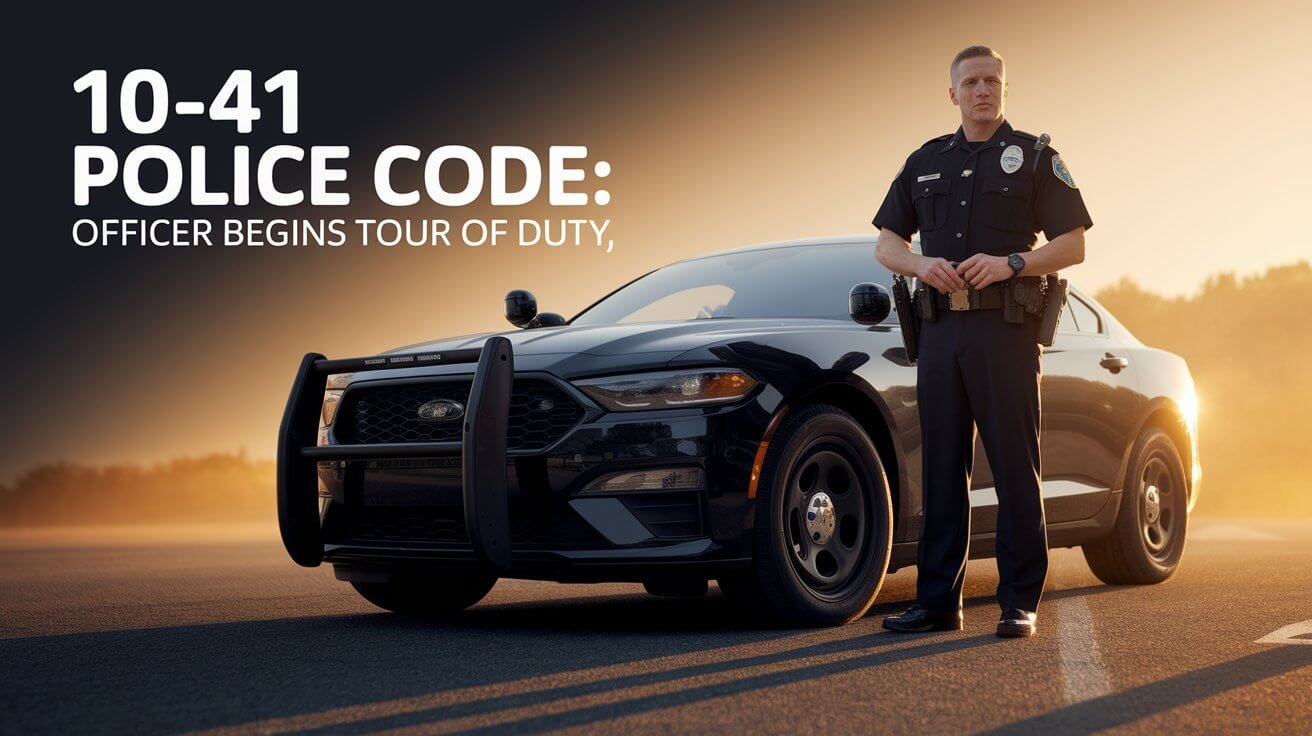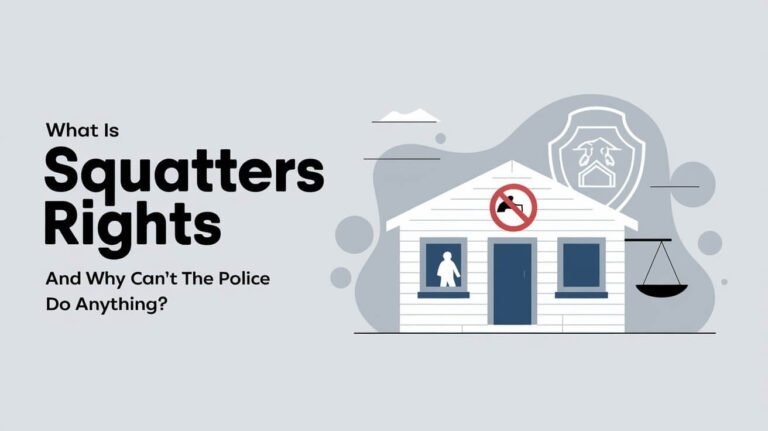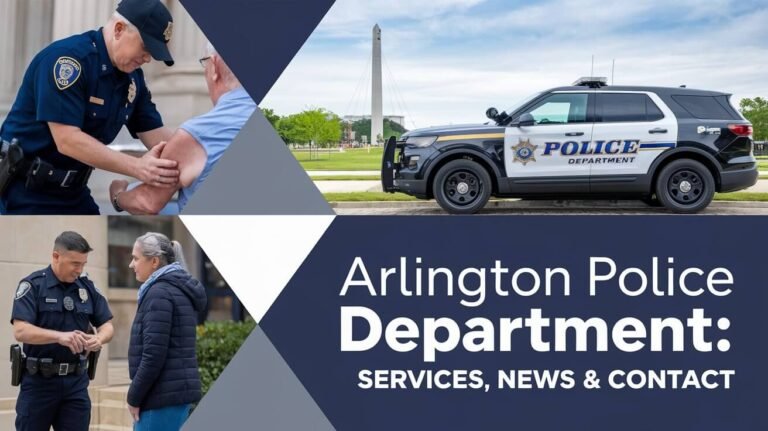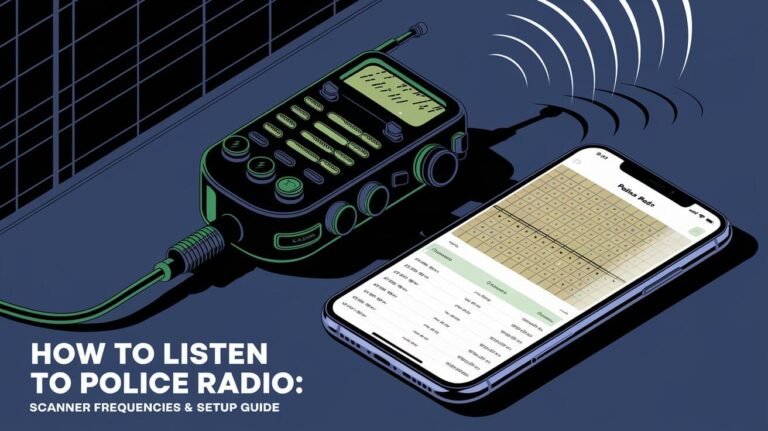10 41 Police Code: Officer Begins Tour of Duty

Law enforcement agencies rely on a standardized system of communication to ensure clarity and efficiency in their operations. One crucial aspect of this system is the use of specific police radio codes to convey vital information quickly.
The 10-code system has been a cornerstone of law enforcement communication for many years, providing a concise way to transmit complex information. Within this system, the 1041 code holds significant importance as it signifies the beginning of a tour of duty, marking the start of an officer’s shift.
Understanding the meaning and application of such codes is essential for effective communication between dispatchers and officers, ensuring that operations run smoothly and safely.
Key Takeaways
- The 1041 code is used to indicate the start of an officer’s tour of duty.
- It is part of the broader 10-code system used in law enforcement.
- Effective use of police radio codes enhances communication between dispatchers and officers.
- Clear communication is critical for the safe and efficient execution of law enforcement operations.
- The 10-code system is a standardized method of communication in law enforcement.
The 10-41 Police Code Explained
Understanding the 10-41 police code is essential for grasping how officers report their status. The 10-41 code is a fundamental component of police dispatch protocols, used to indicate the beginning of an officer’s tour of duty.
Official Definition in Law Enforcement
According to the APCO (Associated Public-Safety Communications Officers) standards, 10-41 signifies “Beginning Tour of Duty.” This code is crucial for officer status reporting, as it informs dispatch that an officer is now on duty and available for assignments.
Beginning Duty Status Reporting
When an officer begins their shift, they use the 10-41 code to report their status to dispatch. This radio communication example illustrates how officers use codes to keep dispatch informed about their availability and location. For instance, an officer might radio in “10-41” to signal they are starting their tour.
Radio Protocol Examples
Effective police dispatch protocols rely on clear and concise communication. Officers are trained to use specific codes like 10-41 to streamline their interactions with dispatch. Examples of radio protocols include:
- Reporting for duty with “10-41”
- Providing location updates
- Requesting backup or resources when needed
Using standardized codes, officers can quickly convey their status, ensuring that dispatch can coordinate responses efficiently.
Origins and Development of Police Radio Codes
The development of police radio codes was a significant milestone in standardizing law enforcement communication. The ten-code system, which includes codes like 10-41, was developed by the Association of Public-Safety Communications Officials (APCO) to improve the efficiency and clarity of police radio communications.
Creation of the Ten-Code System
The ten-code system was created to address the confusion caused by different communication methods used by various law enforcement agencies. APCO played a crucial role in standardizing these codes.
How 10-41 Became Standard Practice
The 10-41 code, indicating “beginning duty,” became an essential part of daily police operations. Its widespread adoption was facilitated by APCO’s efforts to standardize police radio codes across different jurisdictions.
Historical Communication Challenges
Before the ten-code system, law enforcement faced significant communication challenges, including confusion between different codes used by various agencies. The standardization brought about by APCO’s ten-code system greatly improved inter-agency communication.
| Code | Description | Usage |
|---|---|---|
| 10-41 | Beginning Duty | Daily shift start |
| 10-42 | Ending Duty | Daily shift end |
| 10-7 | Out of Service | Unavailable for calls |
How Officers Use the 10-41 Police Code Daily
At the start of every shift, law enforcement officers utilize the 10-41 police code to update their status with dispatch. This crucial step signifies that they are beginning their duty and are ready to take on assignments.
Shift Start Procedures
When officers start their shift, they follow a standard procedure that includes checking in with dispatch using the 10-41 code. This check-in process is vital for maintaining accurate records of officer availability and location. By using the 10-41 code, officers can quickly and efficiently communicate their status.
Dispatch Coordination
Dispatch coordination is another critical aspect where the 10-41 code plays a significant role. Once officers have checked in, dispatch can allocate tasks and assignments based on the officers’ status and location. This coordination ensures that responses to emergencies are timely and effective.
Documentation Requirements
Proper documentation is essential in law enforcement, and the use of the 10-41 code aids in maintaining accurate records. Officers’ status updates are logged, creating a clear timeline of their activities throughout their shift. This documentation is crucial for both operational efficiency and accountability.
Integrating the 10-41 police code into their daily routines, officers can ensure seamless communication and coordination with dispatch and other units. This practice is fundamental to the effective operation of law enforcement services.
Regional Differences in 10-41 Usage
The usage of the10-41 police code varies across different regions in the United States. While the code itself is standardized, its application can differ based on local practices, departmental policies, and geographical considerations.
East Coast vs. West Coast Practices
The East Coast and West Coast have different historical and operational contexts that influence their use of the10-41 code. For instance, densely populated urban areas on the East Coast might use the code more frequently due to higher call volumes. This highlights differences in10-41 usage between the two coasts.
Rural and Urban Department Variations
Rural departments may use the10-41 code less frequently compared to urban departments, where the code is essential for managing high volumes of calls and coordinating responses. This variation showcases regional variations in police codes.
Canadian Border Differences
Near the US-Canada border, there might be additional protocols or variations in using the10-41 code due to cross-border operations and coordination. This includes considerations for US-Canada police code differences.
| Region | Usage Frequency | Notable Practices |
|---|---|---|
| East Coast | High | Frequent use in urban areas |
| West Coast | Moderate | Varied use in urban and rural areas |
| Rural Areas | Low | Limited use due to lower call volumes |
| US-Canada Border | Moderate | Special protocols for cross-border coordination |
Complete Family of Duty Status Codes
Law enforcement agencies utilize a range of duty status codes to manage officer availability and task allocation effectively. These codes are crucial for maintaining clear communication and ensuring that officers are properly coordinated during their duties.
The 10-41 police code, indicating the start of a tour, is part of a larger family of duty status codes. Understanding these codes is essential for effective law enforcement operations.
10-42: End of Tour
The 10-42 code signifies the end of a tour of duty, serving as a counterpart to the 10-41 code at the beginning. This code is used to update the officer’s status, indicating they have completed their assigned tasks and are concluding their shift.
10-7 and 10-8: Out of Service and In Service
The 10-7 code is used when an officer is out of service, meaning they are currently unavailable for calls or other duties. Conversely, the 10-8 code indicates that an officer is in service, signifying they are available and ready to respond.
Relationship Between Status Codes
The duty status codes, including 10-41, 10-42, 10-7, and 10-8, work together to provide a comprehensive system for tracking officer status. These codes are interrelated, allowing for a smooth transition between different duty states. For instance, an officer might go from being 10-7 (out of service) to 10-8 (in service) after completing a task, and then 10-42 (end of tour) when their shift concludes.
Understanding and utilizing these police status codes effectively, law enforcement agencies can enhance their operational efficiency and improve officer safety.
Officer Safety and the 10-41 Protocol
The 10-41 police code is more than just a routine check-in; it’s a vital procedure that contributes significantly to officer safety. By verifying an officer’s location and status at the start of their shift, the 10-41 protocol enhances situational awareness and facilitates resource allocation.
Location Verification Procedures
When an officer checks in using the 10-41 code, they provide their location, which is then recorded by dispatch. This information is crucial for ensuring that officers are where they are supposed to be and for allocating backup resources if needed.
Key aspects of location verification include:
- Confirming the officer’s geographical location
- Verifying the officer’s status (e.g., available, busy, or en route)
- Updating the officer’s status in the dispatch system
Backup and Resource Allocation
The information gathered through the 10-41 protocol is essential for effective backup and resource allocation. By knowing an officer’s location and status, dispatch can respond more effectively in case of an emergency.
Critical Incidents During Shift Changes
During shift changes, the 10-41 code helps ensure a smooth transition by verifying the status and location of incoming and outgoing officers. This is particularly important during critical incidents, where timely and accurate information can be the difference between safety and risk.
| Procedure | Purpose | Benefit |
|---|---|---|
| 10-41 Code Check-in | Verify officer location and status | Enhances officer safety and situational awareness |
| Dispatch Coordination | Allocate resources and backup | Improves response times and effectiveness |
| Shift Change Protocol | Ensure smooth transition | Reduces risk during critical incidents |
Modern Technology Replacing Traditional 10-41 Police Code
The traditional use of police codes like 10-41 is being reevaluated with the emergence of modern technology. Law enforcement agencies are adopting new tools that enhance efficiency and accuracy in their daily operations.
Mobile Data Terminals
One significant advancement is the use of mobile data terminals (MDTs). These devices allow officers to check in digitally, reducing the reliance on voice radio communications. MDTs provide a more efficient and less error-prone method of reporting status updates.
Automated Check-in Systems
Another innovation is the implementation of automated check-in systems. These systems further streamline the process of reporting duty status, minimizing the need for manual radio checks. Automated systems can also reduce the administrative burden on dispatch centers.
Biometric Verification Methods
Some agencies are exploring biometric verification methods to enhance security and efficiency. Biometrics, such as fingerprint or facial recognition, can be used to verify an officer’s identity and status quickly. This technology has the potential to significantly impact how law enforcement agencies manage their personnel’s duty status.
The integration of these technologies is transforming the landscape of law enforcement communication. Key benefits include:
- Increased efficiency in reporting duty status
- Reduced errors in communication
- Enhanced security through advanced verification methods
As law enforcement continues to adopt modern technology, the traditional use of codes like 10-41 will likely evolve, becoming more integrated with digital systems.
Police Codes in Popular Media and Culture
The use of police codes in popular media not only reflects their real-world importance but also influences public perception. Police codes, including the 10-41 code, have been featured in various TV shows and movies, often adding a layer of authenticity to law enforcement scenes.
TV Shows and Movies
Many crime dramas and action films incorporate police codes into their storylines. This inclusion can make the depiction of law enforcement more realistic and engaging for audiences. However, it can also lead to a dramatized representation that may not accurately reflect real-world police procedures.
Scanner Enthusiasts and Citizen Monitoring
Scanner enthusiasts and individuals who monitor police radio communications closely follow police codes. This hobby has been facilitated by advancements in technology, allowing enthusiasts to stay informed about law enforcement activities in their areas.
Public Misconceptions
While the portrayal of police codes in media can spark interest, it can also lead to public misconceptions. For instance, some people might assume that police codes are used universally, not understanding that different departments may have varying protocols.
| Media Representation | Real-World Usage |
|---|---|
| Dramatized for entertainment | Practical application for efficiency |
| Often standardized for narrative | Varied across different departments |
Legal Framework for Police Radio Communications
Police radio communications are governed by a complex legal framework that ensures their effectiveness and security. This framework is crucial for maintaining public safety and facilitating coordination among law enforcement agencies.
FCC Regulations
The Federal Communications Commission (FCC) plays a pivotal role in regulating police radio communications. The FCC is responsible for allocating specific frequencies for law enforcement use, ensuring that police communications do not interfere with other critical services. Additionally, the FCC sets guidelines for the technical standards and operational practices that law enforcement agencies must follow when using radio communications.
Encryption and Privacy Issues
Police radio communications often involve sensitive information, raising concerns about privacy and the need for encryption. Law enforcement agencies must balance the need to protect sensitive information with the requirement to comply with regulations regarding the use of encryption. This balance is critical to maintaining public trust while ensuring officer safety.
Court Cases Involving Radio Traffic
Several court cases have addressed issues related to police radio communications, including the use of encryption and the privacy of radio transmissions. For instance, courts have ruled on cases involving the interception of police radio communications, highlighting the legal complexities surrounding these issues. These cases underscore the importance of a clear understanding of the legal framework governing police radio communications.
Myths and Facts About the 10-41 Code
Despite its widespread use, the 10-41 code is frequently misunderstood, with many myths surrounding its application. The code is used consistently across many departments for its intended purpose, but variations in departmental policies can lead to confusion.
Common Misinterpretations
One common misconception is that the 10-41 code is used for a specific emergency situation. However, its actual purpose is to indicate that an officer has begun their duty. Misinterpretation can lead to confusion among officers and dispatchers.
Actual Field Applications
In reality, the 10-41 code is used daily by officers to report their status. It is an essential part of their communication with dispatch, helping to ensure a smooth operation.
Departmental Policy Variations
While the core purpose of the 10-41 code remains the same, departmental policies can vary. Some departments may require additional information to be transmitted along with the 10-41 code, such as location or officer status.
The Plain Language Movement vs. Traditional Codes
As the plain language movement gains momentum, its implications on traditional police codes are being closely examined. The law enforcement community is at a crossroads, weighing the benefits of clear, straightforward communication against the efficiency and brevity of coded messages.
NIMS and Federal Guidelines
The National Incident Management System (NIMS) has been a driving force behind the adoption of standardized communication practices across the United States. NIMS promotes the use of plain language to facilitate interoperability during multi-agency responses. Federal guidelines have supported this shift, advocating for communication practices that enhance clarity and reduce the potential for misunderstandings.
Arguments For and Against Code Systems
Proponents of traditional code systems argue that they offer a concise and efficient means of communication, particularly in high-stress situations. Codes like 10-41 allow officers to quickly convey complex information. However, opponents counter that these codes can lead to confusion, especially when personnel from different agencies are involved.
Multi-Agency Response Challenges
During multi-agency responses, the use of different codes can create significant challenges. Plain language can mitigate these issues by ensuring that all parties understand the information being communicated. This is particularly crucial in high-pressure situations where clarity is paramount.
| Communication Method | Advantages | Disadvantages |
|---|---|---|
| Plain Language | Enhanced clarity, reduced confusion | More verbose, potentially slower |
| Traditional Codes | Concise, efficient | Potential for confusion between agencies |
The debate between plain language and traditional codes is ongoing. As law enforcement continues to evolve, finding a balance between clarity and efficiency will be crucial. The adoption of NIMS and federal guidelines on plain language reflects a broader effort to standardize communication practices, enhancing the effectiveness of law enforcement responses.
Last Thoughts
The 10-41 police code is a fundamental element in law enforcement communication, signifying the beginning of an officer’s duty period. This code, along with others, has been integral to police radio communication, facilitating efficient and clear exchanges between officers and dispatchers.
Throughout this article, we have explored the origins, usage, and evolution of the 10-41 code, as well as its place within the broader context of police radio codes. From its historical development to its current application, the 10-41 code has played a crucial role in law enforcement operations.
As law enforcement agencies continue to adopt modern technologies, such as mobile data terminals and automated check-in systems, the reliance on traditional codes like 10-41 may diminish. Nonetheless, understanding these codes remains essential for grasping the complexities of police communication and the history of law enforcement practices.
In summary, the 10-41 police code and other related codes are vital components of law enforcement communication. Their significance extends beyond current practices, offering insights into the history and development of policing. As we move forward, it is essential to appreciate the role these codes have played in shaping law enforcement operations.
Reader Questions
What is the 10-41 police code used for?
The 10-41 police code is used to indicate the start of an officer’s shift, informing dispatch that they are now on duty.
What is the significance of the 10-code system in law enforcement?
The 10-code system, including the 10-41 code, was created to improve efficiency in police communication, making it easier for officers from different departments to communicate effectively.
How does the 10-41 code vary across different regions and departments?
The application of the 10-41 code can vary across different regions and departments, with practices on the East Coast differing from those on the West Coast, and rural departments using the code differently than urban ones.
What other duty status codes are related to the 10-41 code?
The 10-42 code is used to signify the end of a tour, while the 10-7 and 10-8 codes are used to indicate when an officer is out of service or in service, respectively.
How is modern technology changing the use of the 10-41 police code?
Mobile data terminals, automated check-in systems, and biometric verification methods are being used to enhance security and efficiency, reducing the reliance on traditional radio codes like 10-41.
What is the legal framework governing police radio communications, including the 10-41 code?
The use of police radio codes, including 10-41, is governed by FCC regulations, with concerns about encryption and privacy, as police communications often contain sensitive information.
What is the plain language movement, and how does it relate to traditional codes like 10-41?
The plain language movement advocates for standardized practices using plain language, which can enhance clarity, especially in multi-agency responses, as opposed to traditional coded communication.
How do scanner enthusiasts and citizen monitoring affect the use of police codes like 10-41?
Scanner enthusiasts closely follow police radio communications, which can sometimes lead to public misconceptions about the actual use and meaning of these codes.
What role does the 10-41 code play in officer safety?
The 10-41 code helps dispatch verify an officer’s location, which is crucial for allocating backup and resources, enhancing officer safety.
Are there any common myths or misconceptions about the 10-41 code?
Yes, some may misunderstand the meaning or application of the 10-41 code, although it is used consistently across many departments for its intended purpose.






